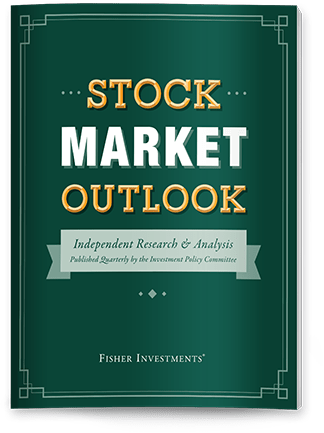Personal Wealth Management / Expert Commentary
What Can You Fathom That Others Find Unfathomable? | The Only Three Questions That Still Count

Ken Fisher, Founder, Executive Chairman, and Co-Chief Investment Officer of Fisher Investments, delves into the second of three key questions from his best-selling book, The Only Three Questions That Still Count: What can you fathom that others find unfathomable? According to Ken, the ability to see connections and realities that others miss can potentially provide a significant advantage for investors. He argues that the world is changed by things that have never been done before, and developing this unique way of thinking is crucial for success.
Ken explains that by identifying a reality that others don't recognize, you can position yourself to benefit when that reality plays out. Ken provides examples he has used throughout his career, including the yield curve shifts and presidential term patterns. He demonstrates how these once-unfathomable concepts, when backed by data, can become powerful tools for navigating the market.
View Transcript
Ken Fisher:
So, each month now I'm providing you some input from parts of my Only Three Questions That Still Count book, which is got another revision coming up to it with updated data in it that should be out in November. And the three questions themselves are just simply timeless questions. The first one is What do you believe that's actually false? It's a great self-testing mechanism to keep you away from conventional wisdom that's wrong and doesn't work. The second one is What can you fathom that others find unfathomable? And that's what I'll talk about today. And then the third one is, What the heck is my brain doing to blindside me right now? And I'll cover that just before the book comes out. But in my life, I learned a long time ago that it's the things that other people aren't doing yet that matter, whether in commerce or in marketplaces. The fact is, the world is changed by never yet done things and always has been. It's a way of thinking that most people don't have. So, for example, in schools they'll talk to you about creativity, but then they'll try to teach you how to think. In business, they'll teach you best practices, but they won't teach you never yet done practices because they can't. You have to come up with them on your own. And what can you fathom that other people find unfathomable starts from the wonderful world of wondering. I wonder if X could cause Y when nobody's thought about it. I wonder what makes Z happen, I wonder, I wonder, I wonderful. Actually, in my mind, pretty wonderful. One of the beauties of AI these days is you can ask all kind of AI platforms simple questions and you get back the standard view of what is online that's the answer to those questions. The beauty of that is it tells you what is it that's the standard, if you will, best practices. And then you say to yourself, "What can I fathom that it doesn't fathom?" That's powerful, because if you can actually find a reality where X causes Y and everybody else doesn't know it, then when you see X happening, you can go to bet on Y. That's pretty nice thing. In my lifetime, I've had success doing that numbers of times. Not nearly as many as I'd like, but numbers of times. And in the book I talk about those somewhat. Let me give you some of them. A long time ago I learned the power of shifts in the yield curve. The way most people—yield curve is the spread between short-term and long term interest rates. So, you know, if short-term interest rates are here and long-term interest rates are here, that creates a graph that slopes upward. And people know that's there, but they don't really think of what is it that this does as this shifts around. Now, what it does is it reflects—imperfectly—the eagerness of banks to lend in the future. And the more banks prone to lend, the more they lend to those that need to borrow. You know the old saying that the business of a bank is to lend to people that don't need the money? That's not really quite right. That's that's a, you know, a mythology that evolved from the people who would like to be able to borrow money but don't qualify for a loan. It's the people who qualify for a loan when the banks are ready to lend that, get the money. And sometimes banks aren't so ready to lend because when short-term rates are above long term rates, it's hard for them to make a profit on a loan because they take in short-term deposits as the basis for making long-term loans. When it's the other way around, big profit margin, a big fat spread, and they make money lending. Understanding that that impacts the growth versus value spectrum is an important thing. So, let me take that and take that fathomable to 2025. At the beginning of the year, I said in January that this would be a year where non-US stocks would do better than US stocks. Not singularly, but a significant part of that was because in 2024, the yield curve, which had been inverted in the middle of 2024, short-term rates above long-term rates, outside of America had gotten to be nicely upward sloping, whereas in America it had not. What does that do? Well, it provides financing to the entities that otherwise have a hard time getting financing. What entities are those? They're the value stocks, not the growth stocks. The growth stocks can always get financing. Where are the value stocks? They're mostly outside of America, not inside of America, including Industrials, banks and others. So, if you take a country like Spain this year, where the market is up by over 30%, half of the Spanish stock market is banks. The banks are in the business of getting much more profit when short-term rates are below long-term rates, and they can lend more aggressively. But then also Industrials across the spectrum of Europe and Asia, more so than in America where we have a much higher growth component. Effectively that shift in the yield curve determines those. Let me give you another one that's in the book. Another one that's in the book is the unfathomable that there is a predictable cycle in America that ripples around the world, tied to our election cycles. Because the fact of the matter is, and I show you this, almost all, not all, but almost all negative years in the stock market happen in the first two years of presidents terms. In the third year of a president's term, we haven't had negative third year since 1939, when the stock market was only down nine-tenths of 1% in the S&P 500. And when you see that long history, you say "Why?" And the rippling feature and I take you through that in the book. That's unfathomable to most. That's the power of the midterm elections, which set up almost all political activity that presidents try to undertake with Congress in the first two years of the term. And political activity causes turmoil that frightens in this way. In politics, if we give to these, we somehow, someway take from those whether that's recognized or not. There's no free lunches there. And the people that you take from hate it more than the people you give to like it. And the more that goes on, which in America happens pretty much exclusively in the first two years of president's terms, all major legislation, like this year's so-called One Big Beautiful Bill, happened in the first two years of president's terms, not the third and fourth years. Then, just little stuff happens. Those things make some people happy, but they make others unhappy. The people that are unhappy hate it more than the people who like it love it. That causes more political risk aversion. Political risk aversion rising makes the stock market more volatile. People become more afraid there'll be more bad things happening, and that makes the market often volatile. You can see this in the data. I take you through this in great length in the data. It's an unfathomable to most people. Why is it an unfathomable to most people? Because most people in America, if they're on the left ideologically or on the right, believe that it's their way or the highway, and they can't quite get the notion that when it's their way, somebody else is really unhappy about it. And the midterms ameliorate that and move you to the third year where you just don't get negativity. I point that out because it's been working for so long. I've been using it for so long, but still, whenever I tell people about it, they think it's stupid. The more they think it's stupid, the more it's to them unfathomable, the more it's unfathomable to them, but you can prove with the data that it's true, the more you know you've got something. And that's what the chapter of What Can You Fathom That Others Find Unfathomable is all about, and I hope would be useful for you. Thank you for listening to me. I hope you like the revised version of the book when it comes out in November.

Where Might the Market Go Next?
Confidently tackle the market’s ups and downs with independent research and analysis that tells you where we think stocks are headed—and why.




